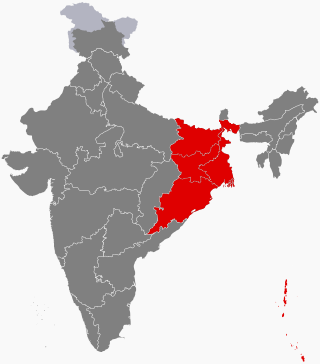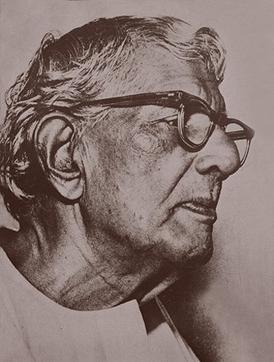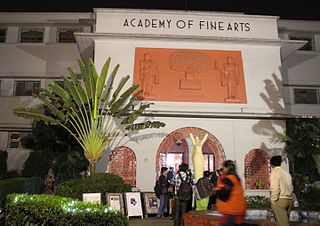
Kolkata is the capital and largest city of the Indian state of West Bengal. It lies on the eastern bank of the Hooghly River, 80 km (50 mi) west of the border with Bangladesh. It is the financial center of eastern and northeastern India. According to the 2011 Indian census, Kolkata is the seventh-most populous city in India, with a population of 4.5 million residents within its city proper. Greater Kolkata has a population of 15 million residents. Kolkata is a historically and culturally significant city in the historic region of Bengal. It is the second largest Bengali-speaking city.

Nandikar is a theatre group in India. The group has its headquarters in Kolkata in the state of West Bengal, but works around the world.

Kalighat painting, Kalighat Patachitra, or Kalighat Pat is style of Indian paintings which originated in the 19th century. It was first practiced by a group of specialized scroll painters known as the patuas in the vicinity of the Kalighat Kali Temple in Kolkata, in the present Indian state of West Bengal. Composed of bold outlines, vibrant colour tones, and minimal background details, these paintings and drawings were done on both hand-made and machine manufactured paper. The paintings depicted mythological stories, figures of Hindu gods and goddesses, as well as scenes from everyday life and society, thereby recording a socio-cultural landscape which was undergoing a series of transitions during the 19th and early 20th century, when the Kalighat pat reached its pinnacle.

Kalighat is a locality of Kolkata, in Kolkata district, West Bengal, India. One of the oldest neighbourhoods in South Kolkata, Kalighat is also densely populated — with a history of cultural intermingling with the various foreign incursions into the area over time.

East India is a region of India consisting of the Indian states of Bihar, Jharkhand, Odisha and West Bengal and also the union territory of the Andaman and Nicobar Islands. The region roughly corresponds to the historical region of Magadha from which it inherits its various Eastern Indo-Aryan languages.

Jamini Roy was an Indian painter. He was honoured by the Government of India the award of Padma Bhushan in 1954. He remains one of the most famous pupils of Abanindranath Tagore, another praised Indian artist and instructor.
Kolkata has many festivals throughout the year. Durga Puja is the largest festival of West Bengal, and it features colourful pandals, decorative idols of Hindu goddess Durga and her family, lighting decorations and fireworks. Other major festivals are Diwali, Kali Puja, Holi, Saraswati Puja, Poush Parbon, Poila Boishakh, Eid al-Fitr, Eid al-Adha, etc.

The Academy of Fine Arts, in Kolkata is one of the oldest fine arts societies in India. The galleries of the Academy provide a whopping 6,300 square feet of space and has an auditorium, a conference centre, and several important and priceless collections of paintings, textiles, etc.

The culture of West Bengal is an Indian culture which has its roots in Bengali literature, music, fine arts, drama and cinema. Different geographic regions of West Bengal have subtle as well as more pronounced variations between each other, with Darjeeling Himalayan hill region and Duars showing particularly different socio-cultural aspects. Culture of West Bengal has adopted many cultural aspects from Bangladesh and shares culture with Bangladesh in many ways.
There are several theories about the origin of Kolkata, erstwhile Calcutta in English, the name of the capital of the eastern Indian state of West Bengal.

The culture of Bengal defines the cultural heritage of the Bengalis or Bangali people native to eastern regions of the Indian subcontinent, mainly what is today the independent state of Bangladesh and the Indian states of West Bengal, Tripura, Assam and Jharkhand, where the Bengali (Bangla) language is the national, the official and the additional official language. The Bengal has a recorded history of 3,100 years.
Sabarna Roy Choudhury was a Zamindar family of Mughal Bengal. They controlled significant swathes of territory, including what would later become Kolkata, prior to the sale of zamindari rights in 1698 to the East India Company.

Kalighat Kali Temple is a Hindu temple in Kalighat, Kolkata, West Bengal, India dedicated to the Hindu goddess Kali. It is one of the Shakti Peethas.

Bikash Bhattacharjee was an Indian painter from Kolkata in West Bengal. Through his paintings, he depicted the life of the average middle-class Bengali – their aspirations, superstitions, hypocrisy and corruption, and even the violence that is endemic to Kolkata. He worked in oils, acrylics, water-colours, conté and collage. In 2003, he was awarded the highest award of Lalit Kala Akademi, India's National Academy of Arts, the Lalit Kala Akademi Fellowship.

Kalighat Milan Sangha FC is an Indian multi-sports club based in Kalighat, Kolkata, West Bengal. Its football team currently competes in the Premier Division of Calcutta Football League.

The group theatre of Kolkata refers to a tradition in theatres in the Indian city Kolkata, which developed in the 1940s as an alternative to entertainment-oriented theatres. As opposed to commercial theatres, group theatre is "a theatre that is not professional or commercial", characterized by its tendency for experimentation in theme, content and production, and its aim of using the proscenium stage to highlight social messages, rather than having primarily making-money objectives.

Raman Siva Kumar, known as R. Siva Kumar, is an Indian contemporary art historian, art critic, and curator. His major research has been in the area of early Indian modernism with special focus on the Santiniketan School. He has written several important books, lectured widely on modern Indian art and contributed articles to prestigious international projects such as the Art Journal, Grove Art Online or The Dictionary of Art, Oxford University Press.

Durga Puja is an annual festival celebrated magnificently marking the worship of the Hindu mother goddess Durga. This festival is the biggest festival in Kolkata.
DAG, previously known as Delhi Art Gallery, is an art house having galleries in India and New York. Started in 1993 in Hauz Khas by Rama Anand, DAG showcases modern Indian artists like Raja Ravi Verma, Jamini Roy, Amrita Sher-Gil, SH Raza among others.




















